Modern Service Industry
Smart Logistics Project of Jilin City
1. Introduction to the Project
1.1 Project background
1.1.1 Product introduction
This project covers an area of 60000 square meters and will construct a smart logistics center in the ship camp area, integrating the construction of a three-dimensional smart cold storage, multi temperature zone smart cold chain cloud warehouse, sorting center, prefabricated vegetable workshop, and inspection and testing center.
Jilin City has obvious agricultural resource advantages and is relatively close to Changchun City, with prominent location advantages. The construction of agricultural smart logistics wholesale projects will combine multiple advantages to give priority to occupying the market in Jilin City and surrounding areas such as Changchun City and Harbin.
1.1.2 Market prospect
(1) Analysis of the current situation of the logistics industry
Logistics refers to the physical flow of goods from the supply location to the receiving location, which integrates basic functions such as transportation, storage, loading and unloading, handling, packaging, circulation processing, distribution, and information processing according to actual needs.
From the perspective of the industrial chain, China’s logistics industry mainly includes upstream hardware equipment and software service providers, midstream warehousing, transportation, distribution, etc. In the downstream application field, China’s warehousing and logistics industry corresponds to multiple downstream industries, including real estate, e-commerce, automotive, retail, pharmaceuticals, etc.
In the more than 40 years since the reform and opening up, China’s logistics industry has developed rapidly: in 1979, OCS Express from Japan became the earliest foreign express delivery company to enter the Chinese market; in 1993, SF Express and Shentong, Guangzhou-Shenzhen Railway Co., Ltd., China’s first joint-stock railway company, and China Railway Dragon Container Logistics Co., Ltd. were successively established.
Since China’s official accession to the WTO in 2001, the logistics industry has entered a new stage of development, promoting the globalization of “Made in China”. During the period of the Tenth Five-Year Plan (2001-2005), the policy emphasized the need to quickly establish a socialized and specialized modern logistics service system nationwide that ensures smooth flow of goods, is fast and timely, economically reasonable, and satisfies customers; During the 11th Five-Year Plan (2006-2010), the national level proposed to vigorously promote modern logistics management technology, strengthen the development and utilization of new logistics technologies, promote logistics informatization, and strengthen the integration of logistics infrastructure; the 12th Five-Year Plan (2011-2015) clearly defined the development goals of the logistics industry: the level of informatization, intelligence, and standardization in the logistics industry has been significantly improved, the logistics service capabilities of key industries have been significantly enhanced, and a modern logistics system that is socialized, specialized, and informationized has been initially established. During the 13th Five-Year Plan (2015-2020), China further reduced costs, increase efficiency, and serve the country as a major strategy for the logistics industry, making it a key task for cost reduction, addressing weaknesses, and promoting supply side structural reform, and focusing on promoting innovative development of the logistics industry.
During the 14th Five-Year Plan, according to the 14th Five-Year Plan for the Construction of the Modern Circulation System, accelerating the construction of modern circulation system, making the flow of goods and resources smoother, and improving commercial and logistics facilities have become important tasks for China’s logistics industry during the 14th Five-Year Plan and the industry has entered a stage of high-quality development.
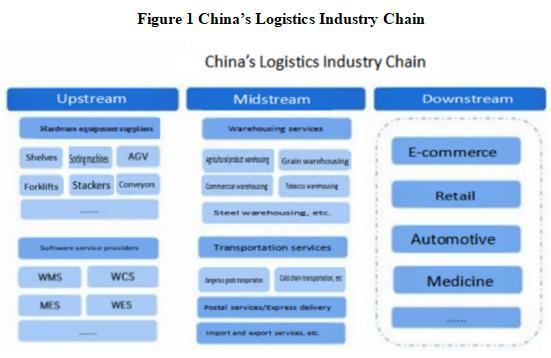
In 2023, the scale of logistics demand reached a new high, with a total social logistics volume of 352.4 trillion yuan, a year-on-year increase of 5.2% calculated at comparable prices. On a quarterly basis, the first quarter, the second quarter, the third quarter, and the fourth quarter saw growth of 3.9%, 5.4%, 4.7%, and 5.4%, respectively, showing a recovery trend of low at first, medium high in the middle, and stable growth finally. The overall growth trend for the whole year is positive.
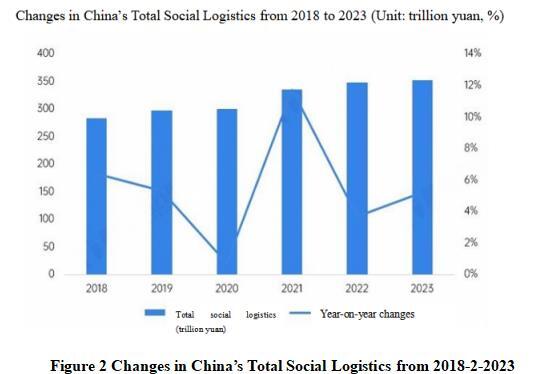
From the composition of the total logistics volume, in 2023, the total logistics volume of industrial products in China exceeded 310 trillion yuan, accounting for over 88%; the next was the total import logistics volume of 18 trillion yuan, accounting for 5.1%; the total amount of logistics in other fields was relatively small.
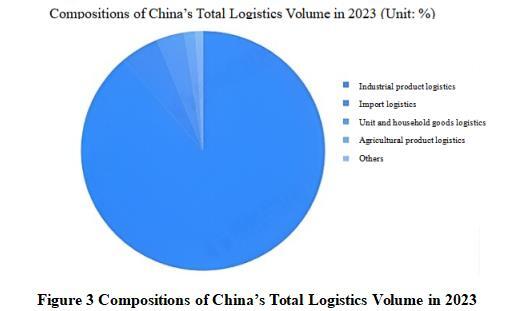
From the perspective of total logistics costs, the total logistics costs in China continue to grow. The total cost of social logistics in 2023 was 17.8 trillion yuan, a year-on-year increase of 2.3%, with a slight decline in growth rate.
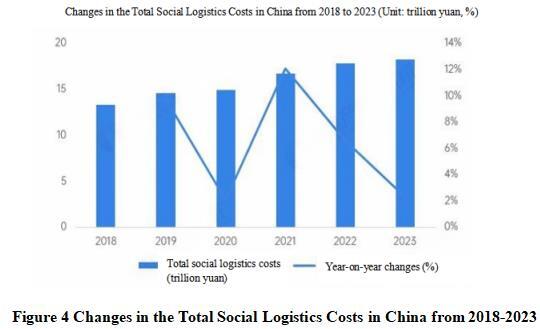
From 2015 to 2023, the overall ratio of total social logistics costs to GDP in China showed a fluctuating downward trend. The ratio of total social logistics costs to GDP was 14.4%, a decrease of 0.3 percentage points from the previous year, reflecting the decreasing logistics costs necessary for the value of unit domestic production (GDP).
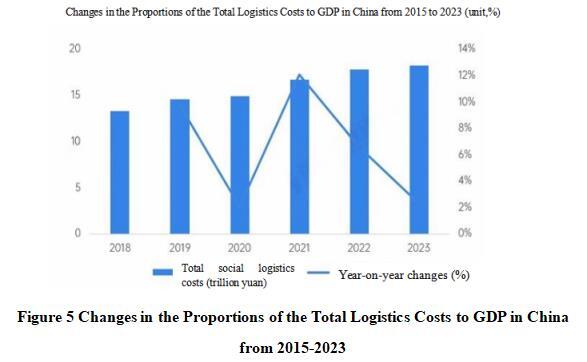
According to data from China Internet of Things, the total revenue of China’s logistics industry has been increasing year by year from 2015 to 2023. The total revenue of the logistics industry for the whole year of 2023 was 13.2 trillion yuan, a year-on-year increase of 3.9%, and the scale of the logistics revenue continues to expand. The year-on-year growth rate of basic logistics revenue such as transportation, warehousing, loading and unloading was around 3%, supporting the stable growth of the logistics market.
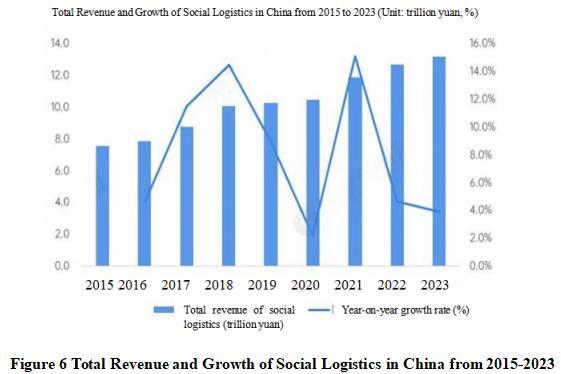
The logistics park plays a significant role in economic development, promoting the integration of multiple transportation modes, and improving the urban environment. In recent years, the government and enterprises have unanimously regarded it as a key project to promote regional and urban logistics development, providing strong support.
As of the end of 2023, the National Development and Reform Commission has led the layout and construction of 80 national logistics hubs, covering 29 provinces (regions, cities) and Xinjiang Production and Construction Corps, laying a solid foundation for accelerating the construction of a modern logistics operation system of “channel+hub+network” and supporting the construction of a new development pattern. From the perspective of regional distribution, Guangdong has the highest number of national logistics hubs.
The National logistics Hub Layout and Construction Plan provides top-level design for China’s modern logistics system, planning to build 212 national logistics hubs in 127 host cities across the country, including land port, port, airport, production service, commercial service, and land border port types. Changchun, Jilin, and Yanbian (Hunchun) in Jilin Province are included, and Jilin City has been designated as a national logistics hub for commercial and service-oriented industries. In 2021, Jilin City actively initiated the application and creation work.
(2) Development trends of the logistics industry
According to the 14th Five-Year Plan for the Construction of Modern Circulation System released by the National Development and Reform Commission, it is expected that by 2035, China’s modern circulation system will be fully established, forming a global, safe, reliable, efficient and smooth circulation network. The efficiency and quality of circulation operation will reach the world’s advanced level, and new advantages in participating in international cooperation and competition will be significantly enhanced. This will provide efficient support for the modern economic system and provide solid guarantees for meeting the needs of the people for a better life. In the coming period, the development direction of China’s logistics industry is as follows:
In the future, China will focus on filling the gaps in the modern circulation system, focusing on the high-quality development of the modern circulation system, accelerating the formation of a unified modern circulation market, and developing the two major systems of modern commercial circulation and modern logistics to further improve China’s logistics system. Based on the trend of changes in the total amount and revenue of social logistics in China in recent years, a forecast is made for the total revenue of social logistics in China in the next few years. By the end of 2029, the total revenue of social logistics in China may have reached 17.9 trillion yuan.
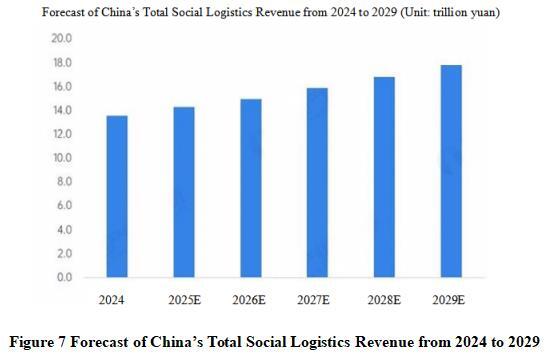
(3) Current situation of the cold chain logistics industry
Cold chain logistics is a professional logistics service that utilizes temperature control, preservation, and other technological processes, as well as facilities and equipment such as cold storage, refrigerated trucks, and refrigerated containers, to ensure that cold chain products are always in a specified temperature environment throughout the entire process of initial processing, storage, transportation, circulation, processing, sales, and distribution. Cold chain logistics, as a fundamental, strategic, and leading industry, is deeply integrated into the high-quality development process of modern agriculture, food processing, medicine and medical industries in China, accelerating the transformation and upgrading of industries, while fully ensuring the daily and emergency supply of“vegetable baskets”, “rice bags”, “fruit plates”, and “meat cases” for people’s livelihood, better meeting the growing demand for a better life of the people.
In recent years, the national level has issued multiple policies related to cold chain logistics, involving multiple departments such as the State Council, the National Development and Reform Commission, the Ministry of Agriculture and Rural Affairs, and the Ministry of Transport, with increasing policy support. For example, the National Development and Reform Commission proposed in the 14th Five-Year Plan for the Development of Cold Chain logistics that by 2025, a cold chain logistics network that connects production and sales areas, covers urban and rural areas, and connects domestic and international markets will have been initially formed, and a cold chain logistics system that is in line with China’s national conditions and industrial structure characteristics, and meets the needs of economic and social development will have been basically established.
With the continuous growth of market demand, support from government policies, continuous improvement of cold chain infrastructure, and driven by technological progress and innovation, the total amount of cold chain logistics in China continues to grow. The Research and Development Prospects Analysis Report on China’s Cold Chain logistics Industry from 2024 to 2029 released by China Academy of Commerce Industry Research shows that the total amount of cold chain logistics in China reached 8.90 trillion yuan in 2023, an increase of 40 billion yuan from 2022 and a year-on-year growth of 4.6%. The total amount of cold chain logistics in China increased to 9.82 trillion yuan by 2024.
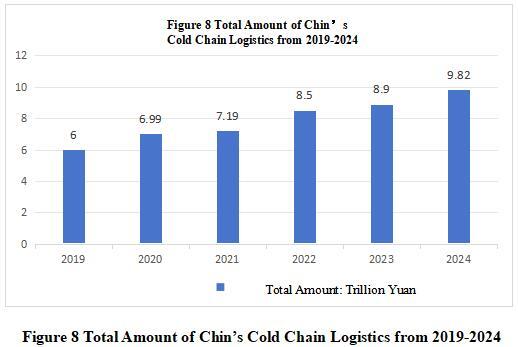
In recent years, the growing demand for people’s daily lives and the development of new formats such as imported cold chain products, fresh e-commerce, community group buying, live streaming e-commerce, and pre-packaged meals have driven the continuous growth of China’s cold chain logistics market. The Research and Development Prospects Analysis Report on China’s Cold Chain logistics Industry from 2024 to 2029 released by China Academy of Commerce Industry Research shows that the scale of China’s cold chain logistics market reached 517 billion yuan in 2023, a year-on-year increase of 5.2%. The size of China’s cold chain logistics market increased to 574.5 billion yuan by 2024.
Cold chain logistics connects the production and consumption ends of modern agriculture, food processing, pharmaceutical products, etc., and is an important support for extending the industrial chain, building the supply chain, and enhancing the value chain. In recent years, with the support of policies and the continuous development of downstream industries, the total demand for cold chain logistics in China has continued to expand. The Research and Development Prospects Analysis Report on China’s Cold Chain logistics Industry from 2024 to 2029 released by China Business Industry Research Institute shows that in 2023, the overall cold chain logistics market in China was under pressure and the demand was gradually stabilizing and recovering. The total demand for cold chain logistics was about 350 million tons, a year-on-year increase of 6.1%.The total demand for cold chain logistics in China reached 387 million tons by 2024.
Cold storage can be regarded as the “base” of cold chain logistics. The construction and development of cold storage has become a top priority for the national backbone cold chain logistics base. The Research and Development Prospects Analysis Report on China’s Cold Chain logistics Industry from 2024 to 2029 released by China Academy of Commerce Industry Research shows that the total amount of cold storage in China was about 228 million cubic meters in 2023, an increase of 18 million cubic meters from the previous year and an increase of 8.3% year-on-year.The total capacity of cold storage in China will have reached 250 million cubic meters by 2024.
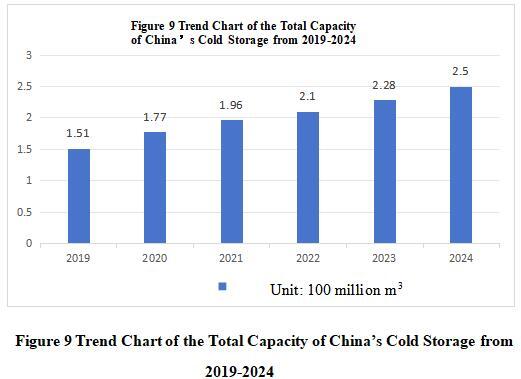
With the increase of policy support, the development prospects of China’s cold chain logistics industry are very broad. In 2024, the No. 1 Document of the Central Committee of the Communist Party of China clearly proposed to promote the transformation and upgrading of agricultural product processing facilities, support the construction of regional pre-cooling and drying, storage and fresh-keeping, fresh cut packaging and other primary processing facilities, and develop intelligent, clean and intensive processing. This demonstrates the high importance and strong support that the country attaches to the development of the cold chain logistics industry. In the 14th Five-Year Plan for the Development of Cold Chain logistics, the country has set the goal of building a cold chain logistics network, requiring the preliminary formation of a cold chain logistics network that connects production and sales areas, covers urban and rural areas, and connects domestic and international markets by 2025. This provides policy support for achieving national and global layout of cold chain logistics.
1.1.3 Technical analysis
By now, the design and refrigeration technology of cold chain logistics have matured, and Jilin Province has a large number of successful cases and professional design teams, which can meet the needs of the project.
1.1.4 Advantageous conditions of project construction
(1) Policy advantages
The Notice on Supporting the Construction of Pilot Cities for Modern Commercial and Trade Circulation System clearly states that we should support the construction and transformation of regional cold chain logistics bases, enhance comprehensive capabilities such as refrigeration, processing, and distribution, connect production, sales, and distribution centers, and connect them with national backbone cold chain material bases, production cold chain preservation equipment, etc., to facilitate the transportation of industrial products to rural areas and agricultural products to urban areas.
The Guiding Opinions on Cultivating Traditional Advantageous Food Production Areas and Local Characteristic Food Industries proposes to strengthen the construction of cold chain logistics facilities for agricultural products such as pre-cooling, storage, and preservation, and fill the gap of the “first kilometer” of food raw materials.
The Ministry of Agriculture and Rural Affairs and the National Rural Revitalization Bureau have issued the Guidelines for Social Capital Investment in Agriculture and Rural Areas (2022), which proposes to “encourage the development of initial processing such as refrigeration and preservation, raw material processing, and graded packaging”, “lay out central kitchens, main food processing, leisure food, convenience food, and clean vegetable processing in the main production areas and suburbs of large and medium-sized cities”, “build a number of storage and preservation, graded packaging, cold chain distribution facilities and equipment, as well as small-scale storage and preservation cold chain facilities in fields”, “encourage places with conditions to build cold chain distribution centers in production areas, create agricultural product logistics nodes, and develop new circulation business format such as supermarkets, agricultural cooperatives, agricultural enterprises, and agricultural schools for production and sales docking”, and “encourage the development of new retail of fresh agricultural products. Support cold chain logistics enterprises to grow bigger and stronger.”
The 14th Five-Year Plan for the Development of Modern logistics proposes to “accelerate the integration and construction of logistics hub resources. Support the functional docking and coordinated development of various logistics centers, distribution facilities, professional markets, etc. with national logistics hubs, promote the scale aggregation and integrated operation of logistics factors.” “Improve the network of cold chain logistics facilities. Give full play to the resource aggregation advantages of national logistics hubs and national backbone cold chain logistics bases, guide enterprises such as commercial circulation and agricultural product processing to gather at hubs and bases or strengthen collaborative connections. Strengthen the construction of production and sales cold chain logistics centers, improve the efficiency of post-production distribution and commercialization processing of agricultural products in production areas, and improve the cold chain logistics system in sales cities.”
The Ministry of Agriculture and Rural Affairs, together with the National Development and Reform Commission, the Ministry of Finance, and the Ministry of Natural Resources, has formulated and issued the National Plan for the Construction of Modern Facility Agriculture (2023-2030), which specifies four key tasks, including the construction of modern logistics facilities mainly for storage, preservation, and drying.
The General Office of the Ministry of Agriculture and Rural Affairs has issued a notice on continuing to do a good job in the construction of refrigeration and preservation facilities in agricultural product production areas, focusing on deploying and improving the network of refrigeration and preservation facilities in production areas, promoting the sinking of cold chain logistics service networks to rural areas, cultivating a group of agricultural product distribution entities in production areas, and innovating a group of agricultural product cold chain logistics operation models to support the construction of refrigeration and preservation facilities in agricultural product production areas.
Nine departments including the Central Finance Office, the Central Agricultural Office, the Ministry of Commerce, the Ministry of Agriculture and Rural Affairs, the National Development and Reform Commission, the Ministry of Finance, the Ministry of Transport, the State Administration for Market Regulation, and the State Post Bureau have issued the Guiding Opinions of the Central Finance Office and Other Departments on Promoting High-quality Development of Rural Circulation. The guiding opinions proposes strengthening the construction of agricultural product storage and preservation cold chain facilities, accelerating the filling of the shortcomings of county and rural logistics facilities, reasonably optimizing the layout of commercial and trade circulation facilities, promoting deep integration of urban and rural circulation, strengthening digital empowerment of rural circulation, cultivating leading enterprises in rural circulation, improving the standard system of rural circulation, and strengthening market supervision in the rural circulation field. Key tasks include improving relevant financial and tax support policies, and enhancing land and talent support, and it is required to make the construction of modern rural circulation system an important part of the five-level secretaries’ efforts to promote rural revitalization, and to strengthen organizational implementation.
The 14th Five-Year Plan for the Development of Service Industry in Jilin Province points out the need to promote the agglomeration development of service industry in city level central cities. Based on local resources, industrial advantages, and urban development, the regional central cities, that is, Jilin, Siping, Liaoyuan, Yanbian, and Changbai Mountain Management Committee integrate service industry resources, optimize service industry development space, and vigorously cultivate and construct various service industry clusters and parks such as commercial logistics, tourism and leisure, cultural education, health and wellness, financial commerce, research and development, and advertising creativity.
The National logistics Hub Layout and Construction Plan provides top-level design for China’s modern logistics system, planning to build 212 national logistics hubs in 127 host cities across the country, including land port, port, airport, production service, commercial service, and land border port types. Changchun, Jilin, and Yanbian (Hunchun) in our province are included, and Jilin City has been designated as a national logistics hub for commercial and service-oriented industries. In 2021, Jilin City actively initiated the application and creation work.
The Investment Promotion Policy of Jilin City clearly states that the investment projects of Jilin City’s Industrial Investment Guidance Fund should comply with national and relevant industrial policies and development plans, with a focus on investing in tourism, medicine and health, aviation, information technology, new materials, advanced equipment manufacturing, biotechnology, energy conservation and environmental protection, new energy, cultural creativity, modern agriculture, modern service industry and other related industries in Jilin City’s “6411” industrial plan, as well as other areas supported by the municipal government for development.
(2) Resource advantages
In 2023, the output value of agriculture, forestry, animal husbandry, and fishery in Jilin City increased by 5.4% year-on-year, which is 0.4 percentage points higher than the whole province. The grain output reached a new high, with a total grain output of 4.672 million tons for the year, an increase of 2.6% over the previous year, and maintained above 4.5 million tons for three consecutive years. Livestock and poultry production grew steadily, with pig and beef cattle output increasing by 4.8% and 11.2%, respectively. Industrial production has taken to the next level.
The main agricultural products in Jilin City include rice, ginseng, black fungus, Ganoderma lucidum, white goose, beef cattle, etc. These agricultural products are not only well-known locally, but also enjoy a high reputation nationwide, forming multiple billion dollar industrial clusters such as rice, beef cattle, white geese, and Changbai Mountain specialties. The agricultural industry structure in Jilin City is increasingly optimized, the production level is improving year by year, and the business model is constantly innovating, which has promoted the modernization development of agriculture.
Jilin City covers an area of 27120 square kilometers, including 918272.95 hectares of arable land. The shipyard covers an area of 688 square kilometers, including 19287 hectares of arable land.
The urban construction land area in Jilin City exceeds 195.9 square kilometers, accounting for 13.0% of the total urban construction land area in Jilin Province.
(3) Industrial advantages
The tertiary industry is the leading industry in the shipbuilding area, accounting for about 80% of GDP. Wholesale and retail trade, as well as the catering industry, are the main industries of the tertiary industry. At present, there are over 2000 commercial enterprises and more than 20000 individual industrial and commercial households in the entire district, including 79 commercial enterprises above designated size and 10 professional markets.
There are over 570 industrial enterprises in the entire district, including 39 large-scale industrial enterprises, mainly distributed in industries such as mechanical processing, wood product processing, food, and power electronics. Agriculture belongs to suburban agriculture, mainly focusing on the cultivation of grain, vegetables, fruits, and economic crops. The total grain output has remained at the level of 125000 tons for several consecutive years; animal husbandry is mainly based on pig, cattle, and chicken farming, accounting for about half of the agricultural output value.
(4) Talent advantages
Jilin City has a large number of high-quality and mature technical workers. After training by enterprises and public welfare institutions, more than 10000 skilled talents are sent to the society every year, and more than 20000 people of various types are trained for the society. The labor resource advantages are obvious, and the proportion of skilled workers is at a high level in the Northeast urban agglomeration. The labor force is in a dividend period, and the labor cost is relatively low. There is a large number of high-quality industrial workers who can meet the needs of various enterprises.
(5) Location and transportation advantages
Chuanying District is the transportation hub of Jilin City.
The entrances and exits of Jilin-Hunchun Expressway, Jilin-Caoshi Expressway, Jilin-Changchun North Line, and Jilin-Changchun South Line are all located within Chuanying District. Major transportation arteries such as Yingbin Road, Western Expressway, Heping Road, Yueshan Road, Wusong Road, and Xiushui Street pass through the Chuanying District. There are more than ten main roads in Chuanying District, including Jiefang Road, Taoyuan Road, Beijing Road, and Songjiang Zhongxi Road; the main trunk line of the Northeast China Expressway Network, the Changchun-Jilin Expressway and Changchun-Jilin North and South Lines, pass through the area. The Jilin-Caoshi Expressway is currently under construction, and it only takes 40 minutes to travel from the expressway to Changchun; adjacent to Jilin City Highway Passenger Transport Center, 2.5 kilometers away from Jilin City Railway Station. The railway provides direct access to major cities in China such as Beijing, Tianjin, Shanghai, Ningbo, and Shenyang; located 60 kilometers away from Changchun Longjia International Airport, more than ten domestic routes have been opened to Beijing, Haikou, Shanghai, Qingdao, Guangzhou, and other destinations.
1.2 Contents and scale of project construction
1.2.1 Construction scale
This project covers an area of 60000 square meters.
1.2.2 Construction contents
The total construction area of the project is 65000 square meters, mainly consisting of 4 three-dimensional smart cold storage buildings, 3 multi-temperature-zone smart cold chain cloud warehouses, 1 sorting center, 2 prefabricated vegetable workshops, 1 inspection and testing center, and 1 comprehensive service center. At the same time, supporting facilities such as hard pavement, greening, and pipeline engineering are also included.
1.3 Total investment of the project and capital raising
1.3.1 Total investment of the project
The total investment of the project is 678 million yuan, including the construction investment of 508.5 million yuan and current funds of 169.5 million yuan.
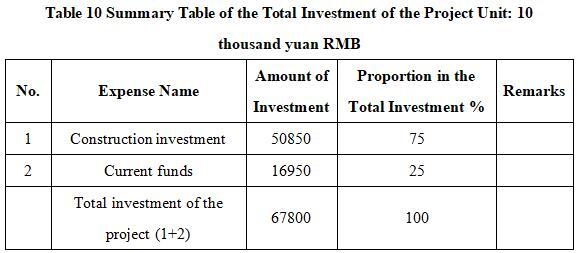
1.3.2 Capital raising
Self-raising by the enterprise
1.4Financial analysis and social evaluation
1.4.1 Main financial indexes
After the project reaches the production capacity, its annual sales revenue will be 643.07 million yuan, its profit will be 130.38 million yuan, its investment payback period will be 8.5 years (after the tax, including the construction period of 2 years) and its return on investment will be 19%.
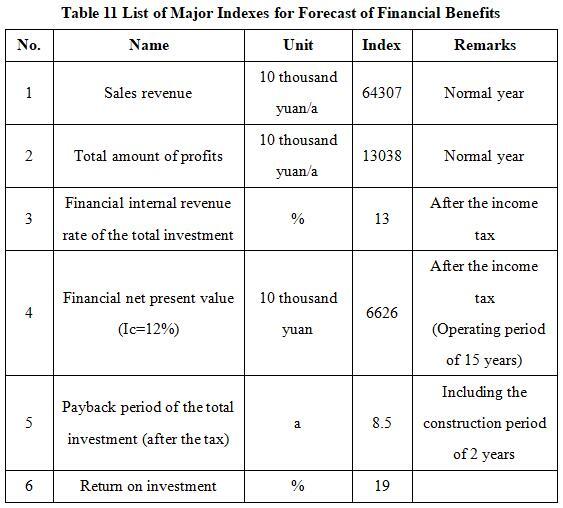
Note: “10 thousand yuan” in the table is in RMB.
1.4.2 Social evaluation
The construction of smart logistics projects is an important part of the process of agricultural modernization. By introducing advanced technologies such as the Internet of Things and big data, we can achieve full traceability and intelligent management of agricultural products, thereby improving their quality and safety. At the same time, smart logistics projects can also promote the extension and expansion of the agricultural industry chain, promote the integration and development of agriculture with the secondary and tertiary industries, and provide strong support for agricultural modernization.
1.5 Cooperative way
Joint venture or cooperation, other methods can be discussed face-to-face.
1.6 What to be invested by the foreign party
Funds, and other methods can be discussed face-to-face.
1.7 Construction site of the project
Changchun Road, Chuanying District, Jilin City, Jilin Province
1.8 Progress of the project
It is attracting foreign investment.
2. Introduction to the Partner
2.1 Basic information
Name: Bureau of Commerce of Chuanying District, Jilin City
Address: Chuanying District, Jilin City
2.2 Overview
Chuanying District is under the jurisdiction of Jilin City, Jilin Province. Located in the central and western part of Jilin City, it has 11 streets, 3 towns, and 1 township under its jurisdiction. The total area is 613 square kilometers, of which the built-up area is 41 square kilometers. The total population of the district is 450000, including 353000 non-agricultural population. In 2019, it was listed as a demonstration county (district) for the National Intellectual Property Strong County Project.
The regional gross domestic product (GDP) of Chuanying District in Jilin City in 2023 is 21.1 billion yuan. In 2023, Chuanying District closely followed the main line of high-quality economic development and vigorously implemented the “Five Special Actions for Economic Construction”, including measures such as project planning, stable income growth, land acquisition and demolition, extensive investment promotion, and strong urban construction, achieving significant growth in multiple economic indices. Specifically, the six key indices in the shipbuilding area have achieved double-digit growth, with three indices ranking among the top three in the city. In addition, Chuanying District has also completed the commencement and resumption of several key projects, including the improvement of medical service capacity of the children’s hospital, reconstruction and expansion of the maternity hospital, and promoted fixed assets investment in a number of non-real-estate projects.
In 2024, Chuanying District continued to anchor the goal of becoming the best district, implemented the “1410” project for high-quality development, focus on economic construction as the central task, and adhere to the bottom line of safety production, social stability, livelihood guarantee, and ecological environment, promoting high-quality economic development.
2.3 Contact method
Postal code: 132000
Contact person: Wang Xinghai
Tel: +86-432-64831206 +86-13596272700
Contact method of the city (prefecture) where the project is located:
Contact unit: Investment Promotion Service Center of Jilin Bureau of Commerce
Contact person: Jiang Yuxiu
Tel: +86-432-62049694
+86-15804325460
E-mail: jlstzcjfwzx@163.com


